
Tenrecs Tenrecs - sex determination
Price for 6+ tests: 34.00 $ without VAT
Subfamily Tenrecineae (Spiny Tenrecs) sexing
- Tenrec ecaudatus -Tail-less tenrec
- Setifer setosus - Greater hedgehog tenrec
- Echinops telfairi - Lesser hedgehog tenrec
- Hemicentetes semispinosus - Lowland streaked tenrec
- Hemicentetes nigriceps - Highland streaked tenrec
Based on the collaboration with the Zoological and Botanical Garden of the city of Pilsen (Czech Republic), Genomia laboratory has determined a specific SRY-marker identifying male gender in the representatives of families Tenrec, Setifer, Echinops and Hemicentetes.
The analysis is based on the determination of the presence or absence of SRY-gene under concurrent use of control genes ZFX-ZFY.
The molecular genetic test enables quick and reliable sex determination with PCR-method in these small mammals. The test can be made in a non-invasive way by a swab of the buccal mucosa.
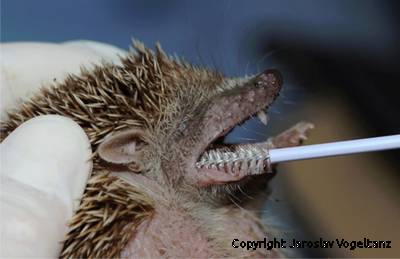
The analysis results will be presented at 33rd conference of the International Society of Animal Genetics (ISAG) - Martina Safrova, Barbora Blahova, Marketa Dajbychova, Katerina Saskova, Katerina Stampachova: Molecular genetic analysis of sexual diversities in Spiny Tenrecs.
Tenrecineae (Spiny tenrecs) is extraordinary subfamily of placental mammals with origin in Madagascar and include in order Afrosoricida .
Afrosoricida (tenrecs and golden moles) with other six groups with little superficial resemblance to each other: Macroscelidea (elephant-shrews), Tubulidentata (aardvark), Hyracoidea (hyraxes), Proboscidea (elephants), Sirenia (dugongs, manatees and sea cows). Groups are based on common ancestor included in supercohort Afrotheria.
Family Tenrecidae the most diverse group of afrotheres, with terrestrial, aquatic, fossorial and arboreal species, includes four subfamilies (Oryzorictinae-Furred tenrecs, Tenrecinae-Spiny tenrecs, Geogalinae -Large-eared tenrec, Potamogalinae-Otter shrews. The rich diversity of tenrecs on Madagaskar is explained by Darwinian theory of "adaptive radiation".
Subfamily Tenrecinae has lots of signs of primitive mammals - cloaca, unstable body temperature, zalambdodont teeth, testes in abdominal cavity, lots of them are active during night, in some species exist special communication "stridulation"and echolocation, long term gravidity, born blind and underdeveloped young. They have also poor eyesight and a dependence on their sense of smell and hearing.
.
Tenrec ecaudatus
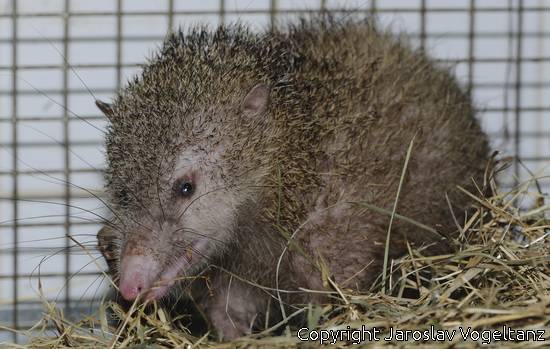
The tailless tenrec is the largest of all the sub-familyspecies, being approximately 27-40 cm long and weighing 2-3 kg. The body is covered with hair and blunt spines, which are not capable of protecting him against enemies. Thus, its only defence consists in escaping; at a short distance, it can run as fast as 50 km/h. When threatened, it also assumes a defensive posture, baring its teeth. It feeds on insects, amphibians, small mammals, and even fruit. Its litter has 12-16 young in average, but as many as 32 were also recorded.
.
Setifer setosus
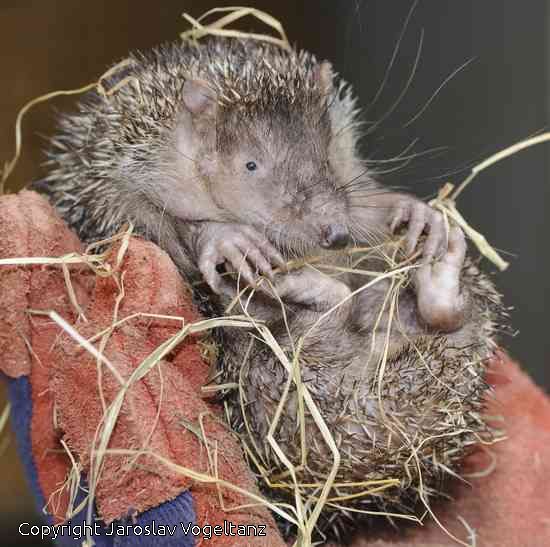
The greater hedgehog tenrec is 15-22 cm long and weighs approximately 180-270 grams. In case of slight danger, it rolls itself into a ball, getting its spines bristled in all directions and snapping its teeth. In greater danger, it emits hissing and spitting sounds and tries to bite its enemy from the ball. In a life-threatening situation, it lapses into a stress, gives out short sounds, and remains curled in the ball with spines erected as high as possible. The litter usually contains 3 young.
.
Echinops telfairi
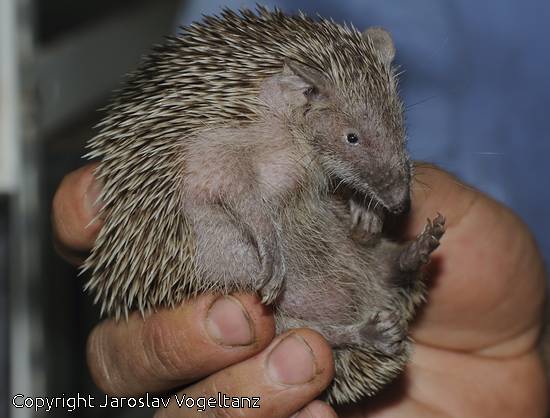
The lesser hedgehog tenrecgrows up to approximately 18 cm and weighs 100-230 grams. It is the smallest species of the sub-familyTenrecidae and also the one most frequently kept in zoo gardens. It feeds mostly on invertebrates. Males producea milky coloured secretion from their preorbitalglands. If threatened, it rolls into a ball.
.
Hemicentetes semispinosus
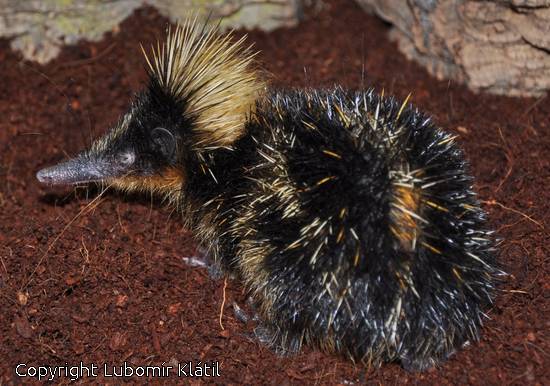
.
Hemicentetes nigriceps
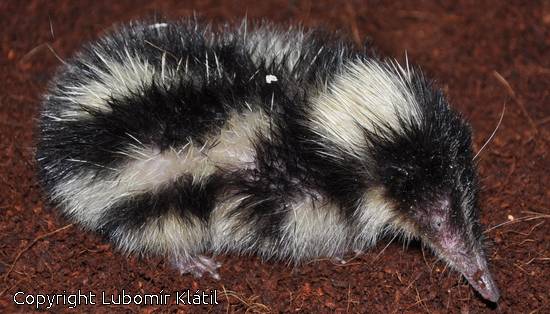
The species of the genus Hemicentetesare unique, as no similar species of mammals have developed anywhere on Earth. Unlike the previous species, these tenrecs live in colonies. Their yellow-black colour warns the predators. If in danger, the animal erects a collar of spines around its neck, which may even be "shot". Swinging its head, it tries to hit the enemy's nose with the spines. These tenrecsare15 to 20 cm long. In these species, the ability of communication through stridulationhas been described, which especially serves as a social communication means among the members of a group. Sounds are emitted by rubbing the stridulation spines on the animal's back. Other sounds emitted by the tongue are a form of echolocation and are probably also used in hunting. These tenrecs feed on earthworms and other invertebrates.
.
References:
Safrova, M., Blahova, B., Dajbychova, M., Saskova, K., Stampachova, K.: Molecular genetic analysis of sexual diversities in Spiny Tenrecs. Poster 33rd conference of the International Society of Animal Genetics (ISAG)
Stephenson, P.J. (2007). Mammals from another time: tenrecs in Madagascar. Africa Geographic, March 2007, Vol 15 (2): 34-41
http://www.afrotheria.net/ASG.html
Hošek P.: Bodlíni nejsou jen bodlinatí aneb první savci na Madagaskaru, Vesmír 83, 2004: 215-219
Result report preview
Price for 6+ tests: 34.00 $ without VAT



